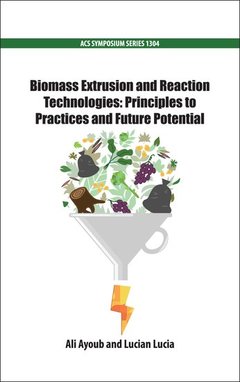Description
Biomass Extrusion and Reaction Technologies
Principles to Practices and Future Potential
ACS Symposium Series
Coordinators: Ayoub Ali, Lucia Lucian
Language: English
Subject for Biomass Extrusion and Reaction Technologies:
Publication date: 10-2019
288 p. · 16.1x23.7 cm · Hardback
288 p. · 16.1x23.7 cm · Hardback
Description
/li>Biography
/li>
Reactive extrusion is an environmentally friendly, cost-effective technology that has the potential to enhance the commercial viability of biomass-derived materials. The process can be applied in order to carry out melt blending simultaneously with various chemical reactions including polymerization, grafting, branching, and functionalization. Therefore, production and processing can be integrated in a single stage, thereby reducing or eliminating the need for extensive, high-maintenance equipment. In general, extrusion is being increasingly applied worldwide to manufacture an expanding list of products. During extrusion, product attributes are controlled by feed composition, the length of time the product remains in the extruder, and also the manipulation of specific mechanical or thermal energy inputs as adjusted by many variables such as temperature, moisture, screw configuration, speed, and feed rate. The choice of the extruder type, screw profile, configuration, and operating conditions can be altered to modify the properties desired in the final product. During the last two decades, the physico-chemical modification of biomass via extrusion has become an important field of research with great potential to produce materials with new properties. New technologies that allow for the efficient conversion of previously unstable materials and/or blending of immiscible polymers offer opportunities for developing new bio-based products with unique properties. Some of these technologies should allow for a nice balance between the desired properties and effective methods for processing to be successful. In addition to the academic interest in these kinds of systems, there is industrial interest due to increasing environmental and economic concerns in recent years. Moreover, replacing existing synthetic procedures with eco-friendly and sustainable processing strategies will open the door to better designed reactors as well as the use of alternative energy resources. One interesting new strategy is to combine supercritical carbon dioxide or irradiation technologies with reactive extrusion to create a wide range of applications in the food and non-food markets. Some examples of applications for biomass-based composites are for filtration devices, membranes, non-woven and paper type products, foams, structural composites, nanocomposites, coatings, fibers, films, biofuels, and electrical devices. The editors believe that in the future many more extrusion reactions will be developed, and that such reactions will help to simplify existing time- and resource-consuming conventional procedures. Extrusion processes offer the potential to transform the use of biomass to produce renewable, sustainable products in ways currently unreported by conventional processes. The future for the application of the extrusion combined technology looks bright on an industrial scale.
Ali Ayoub is an internationally recognized expert in the carbohydrate science and engineering field and has successfully developed groundbreaking inventions in areas relevant to polymeric materials and the biorefinery concept. Currently, he is a Senior Scientist in the chemical industry and an Adjunct Professor and member of the Associate Graduate Faculty at North Carolina State University. Dr. Ayoub is affiliated with the U.S. Department of the Interior, SE Climate Science Center. Lucian Lucia currently serves as an Associate Professor in the Departments of Forest Biomaterials (Wood & Paper Science) and Chemistry and as a faculty in the programs of Fiber & Polymer Science and Environmental Sciences at North Carolina State University. His laboratory, The Laboratory of Soft Materials & Green Chemistry, probes fundamental materials science topics focused on the green chemistry of renewable polymers. He received his Ph.D. in organic chemistry from the University of Florida for modeling photoinduced charge separation states of novel Rhenium (I)-based organometallic ensembles as a first order approximation of photosynthesis.
© 2024 LAVOISIER S.A.S.




